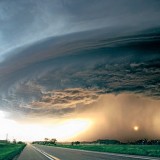“No belief in industrial society is so pervasive and so essential to it as ‘progress’ defined in terms of economic growth. It sustains faith in the industrial system and reinforces the hope among the poor that they may also ‘strike it rich'”. – From Ark II by Dennis Pirages and Paul Ehrlich, 1974.
INTRODUCTION
Many years ago, the ecologist Paul Anderson wrote “The ecological childhood of man is over, and it has ended without ecological wisdom.” For the primary socio-political interests that control our society this, sadly, is still true. Ecological wisdom is more than understanding ecology. It implies understanding both what we are doing in “nature”, and what the consequences of our “doing” may be.
I have reached my own “ecological wisdom”, as it stands now, from decades of work in research, university teaching, and resource management. Such information is for the purpose of self introduction to help readers understand the basis of my perspective.
After 60 years of such experience I am inclined to look back a long way – clear back to my early life. By the same token, I find myself looking far ahead – at the future of my grandchildren, at the future of other grandchildren. This thinking, and the uneasiness it brings, is more than reminiscence about the past or casual thoughts regarding the future. It is a deep concern driven by the massive changes that I have seen, and see, coming in the world around us. It is driven, in one of its dimensions, by the problems that I see in fisheries, my professional discipline.
Around the planet, across North America, and more particularly for this discussion, in B.C., we can witness an endless parade of growth-driven building and “development” projects. On the surface, the process is driven onward by the need for more jobs – jobs for more and more people, but less spoken of, profit and growth for business. The insatiable growth process is circular, there is no “end game”. More people, need for more jobs, use of more resources and space, then more people yet, need for still more jobs, urgency to find more resources – around and around it goes. In many respects this circular syndrome has come to define our culture. In one form or another it has come to define most human cultures. In its present scale, it has come to stress ecosystems at all levels.
We still have some chance to do far better in some parts of the world. The time has come to change direction. Bigger, faster, and more are no longer better.
GLOBALLY – AN EARTH UNDER STRESS
Global ecosystems are under stress from our activities, demands, and impacts. Wherever we look, be it forests, soils, fish populations, water supply, or biodiversity, damage and overuse goes on and expands. The scale of stresses and risks as well is understood and has been spelled out by many authors.
In 2005, the Millennium Ecosystem Assessment Synthesis Report was released. It involved the work of an enormous number of people and organizations. It was designed to assess the consequences of ecosystem change, and to establish a scientific basis for actions to enhance the conservation and sustainable use of ecosystems and their contributions to human well-being. The following are examples from among major findings:
- Approximately 60%, 15 out of 24, ecosystem services evaluated in the assessment are degraded or are being used unsustainably. Most of this had developed in the past 50 years.
- 20 % of the world’s major coral reefs have been lost, 20% more have been degraded.
- 60% of the increase of atmospheric carbon dioxide (at 376 ppm in 2003) has taken place since 1959.
- Humans have changed, to a significant extent irreversibly, the diversity of life on earth.
- Many of the great fisheries of the world are already lost or are in danger of loss in the next few decades.
Much of the following part of my discussion is based on fisheries issues because of my education and experience. However, the challenging elements of human behavior involved transcend fisheries issues.
GLOBALLY – FISHERIES IN TROUBLE
In many regards the situation with fisheries is emblematic of a wider human dilemma. Many, if not most, of the fisheries of the world are in trouble. Among many of them sustainability hangs in the balance or is already lost. This damage to most fisheries has been done by people and fishing, driven in the end by our ever increasing numbers and collective appetites for food and profit. Damage to some fishery resources is not exclusively from overuse.
In some instances the use of one resource has compromised the existence of another. In doing research for the book Fishes and Forestry – Worldwide Watershed Interactions and Management, edited by Northcote and Hartman, it was found that expanding forestry activities had damaged fish habitat and populations at a time before people cared or thought about it. Such damage carried on years after people did know about it. Although our book dealt with forestry effects, it is likely that similar books could be written about impacts on fish populations from mining, agriculture, urban expansion, or other human activities.
Beyond the effects of environmental impacts, growth in fishing, particularly for marine species, has put such resources in jeopardy. In an article in Nature, Aug. 8, Vol. 418, Daniel Pauly and co-authors showed that total catch of invertebrates, groundfish, and pelagic fish rose from about 20 million tons in 1950 to about 80 million tons in 1988. It fell to about 70 million tons by 1999. However, catch data do not tell the whole story. The composition of the total catch has changed through “fishing down”. In “fishing down”, the fishery over time takes a progressively higher fraction of the catch from species that are lower in the food chain.
B.C. – LIKE THE REST OF THE WORLD
In the B.C. salmon fisheries the pressures on the fish are double-barreled. We catch too many of them, and concurrently, we degrade their environment through growth in industry, housing, waste disposal, and resource extraction. Viewed in such a context, salmon in the Fraser River, and indeed in other major rivers face a very uncertain future.
The issues go beyond those of run forecast and allocation, which are regularly in the news. The Fraser River system is under the stress of a configuration of impacts and ongoing growth-driven change. In a chapter in the book Sustainable Fisheries Management – Pacific Salmon, Drs. Northcote, Groot and I listed twelve environmental impacts, including Alcan’s diversion, that endanger salmon runs in the river. Many of these impacts may well occur at low levels of effect, however, collectively they pose a threat.
Effective response to such threats, especially those which may have subtle effects, is difficult without well developed monitoring and assessment. The combinations of impacts that cause the threats may be different for different salmon populations depending on where and when they migrate. The research on cumulative effects, as they may be manifested for different populations in the Fraser River system, has not been done.
Concerned citizens and thoughtful managers do understand some of the “high point” impairments to salmon populations in the system. They recognize some of the most problematic impact sources. The issues and the conflicts involved in “high profile” problems may, however, divert attention from the complexes of current environmental issues and from the heavy duty impacts of long-term macro changes in the environment. The risks exist at two levels.
RISKS AT TWO LEVELS
Fisheries resources, at levels from local to global, are put in jeopardy by competitive fishing and overuse in the short term, and by macro changes in an array of environmental conditions in the long term. Human population size is a pervasive element among the latter. In this regard, it is an interesting and indeed almost a hallmark of my profession, that most biologists struggle hard with issues of “allocation” and “management”, but stand aloof from discussing growth in human numbers as it contributes to fisheries failures. The book Salmon 2100 – the Future of Wild Pacific Salmon by Lackey et al is a notable exception.
Some fisheries can change quickly under the pressure to feed a rapidly increasing human population. I worked in Malawi, Africa, for 2 years on fisheries and environmental projects. In the short course of 3 decades (1960s to 1990s), during which the Malawi population came close to doubling, the fish stocks of the southern end of the lake were over-used and the size range of species captured decreased dramatically. Fish populations along the narrow fishing zones in the mid- and upper lake became over exploited and changed somewhat more slowly. It was acceptable for Malawian managers to search for ways to catch more fish, however, it was not acceptable for them to discuss the impacts of a population that doubled in 30 years or less.
In B.C. and the Pacific Northwest states, population growth will, potentially, play an enormous role in determining the long-term future of salmon. If the current average annual human population growth of the last half of the 20th century (1.9%) continues, Lackey et al. predict that numbers in the Pacific Northwest will reach about 85 million by 2100. I present these numbers not so much as something of certainty, but rather to indicate that if we look into the long-term future, salmon in systems such as the Fraser River face a very problematic future.
Much of BC’s share of future growth will occur in the lower Fraser River basin from Hope to Vancouver with more water pollution, more gravel removal, more roads, more water removal, more subdivisions, etc. Ongoing climate change, expansion of human population, and “development” will be the primary determinants that will shape the freshwater environmental future for the diverse Pacific salmon stocks in the Fraser River system.
A long-term strategy, involving research and related management responses which are scaled to the magnitude of the issues, must be developed for salmon populations of the southern half of B.C. Such research must deal with the implications of expanding human populations and related development and infrastructure.
The rapid growth of human numbers, beyond “sustainability”, is the pervasive element in fisheries management whether in the Fraser River system or other parts of the world. It is the pervasive element in most ecological issues that face society(ies). Whether it is in fishery matters in the Fraser River, fisheries issues around the globe or other some other resource-related concern, biologists must put problems of human population growth, and its unending imbalance, into the “equation”.
TO THE ENVIRONMENTALISTS – CHALLENGE THE GROWTH ETHIC
It is the reality of our times that we must question not only the specifics of each resource use issue and each “development” issue of our time, but also the societal context in which it occurs. Over the past 30 years or more, I have witnessed cases in which people, who were concerned about the environment, questioned or opposed activities that ranged from small to large, and from moderate to heavy in impact.
We have not, however, questioned well the direction or the “end game” along which each step in the growth/development process takes us further. The numbers should wake us up. The UN medium growth projection has human numbers peaking at about 9.3 billion – 3 billion more than now. The US growth projection is for about 420 million by 2050. The Canadian projection is for about 42 million. Based on growth rate from 1950 to 2000, B.C. will have a population of 8 million or more.
The question that we “environmentalists” must ask in regard to these kinds of trends is, “Where does the process take us?” Do we wait, passively, until the growth process takes the planet to the 9 billion plus mark? Do we grow until nature says “Stop,” as it surely will, or do we begin an active discussion of the processes that envelope us? These are the issues. These are the questions that should be asked in every political campaign in which our “leaders”, perhaps in ignorance, take us one increment further along the road to greater environmental risks.
Such questions and issues must begin to be part of every discussion and every hearing as additional “development” projects come before society. The fact that project review formats and terms of reference may not openly permit such discussion, in this day and age, can only serve to emphasize their ultimate limitations.
REACHING FOR A HIGHER RUNG ON THE LADDER
To a large degree it is the political process that reflects the direction of a society. In a deeper sense this process reflects our relationship to our environment and to nature. The political discussion that we have heard is one in which the core of the debate is about the “individual” as opposed to the “collective”. As such, these two perspectives are both about how we use the planet and about how nature may serve our species. It is in this context that we presently try to “write the rules.” A look at the conditions around us tell us that now such “rules” of societal operation are short-sighted. Too many people in our society live with their eyes on the stock market and their hands on their wallets. The environment is an abstraction “somewhere outside.”
My sense of the situation is that we are at a “break-point” at which the “political” context must also reflect rules of nature that are common to all species. Such a transition would reflect intellectual process as much as political doctrine. It would reflect, in the fullest sense, that we cannot “grow forever.” It would also reflect that “all things are interconnected in nature.” The Nuu–Chah-Nulth people on the west coast of Vancouver Island embraced this concept long ago in their expression, “hishuk ish ts’awalk.”
Historically, people have made positive transitional leaps in regard to some things in society, in particular, how they should operate and govern themselves. I think that we are due for another step. I believe that it is time that we recognized nature as a partner and a regulator rather than as a servant and a collection of resources. This idea is an abstraction on one hand, but a powerful reality on the other. In its fullest sense, the concept has no home in any present political organization. It is a concept based on perceived relationships rather than how we gain and own material wealth. As such it may be elusive, and making it work would require new dimensions to our thinking and social depth. However, the consequences of failure to reach for and attain it, because we opt for “business as usual”, may be disruptive and dangerous.
My last hope is that it is not already too late.
G. F. Hartman, Ph.D.




